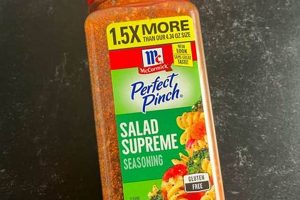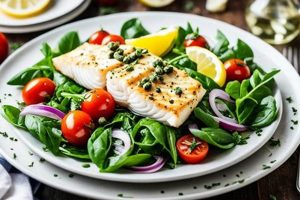This dish, a staple of Thai cuisine, combines shredded unripe papaya with a vibrant blend of flavors. A traditional preparation typically includes ingredients such as tomatoes, green beans, garlic, chilies, fish sauce, lime juice, and palm sugar, pounded together in a mortar and pestle. Variations may incorporate dried shrimp, peanuts, or crab. The resulting salad offers a complex interplay of sweet, sour, salty, spicy, and savory notes, with the crisp texture of the green papaya providing a refreshing counterpoint.
As a light yet flavorful dish, it often serves as an appetizer or side dish accompanying richer curries or grilled meats. Beyond its culinary appeal, it represents a significant aspect of Thai food culture, reflecting the country’s rich agricultural heritage and the balance of flavors prized in its cuisine. The use of the mortar and pestle, a traditional tool, further connects this dish to its historical roots. Its popularity has extended beyond Thailand’s borders, introducing its unique flavor profile to a global audience.
Further exploration will delve into regional variations in ingredient selection and preparation methods, along with detailed recipes and tips for achieving an authentic taste. The nutritional benefits of the dish, highlighting the health properties of papaya and other key components, will also be examined.
Tips for Authentic Thai Green Papaya Salad
Achieving the perfect balance of flavors and textures in this iconic dish requires attention to detail throughout the preparation process. The following tips offer guidance on selecting ingredients and employing techniques that contribute to an authentic culinary experience.
Tip 1: Papaya Selection: Opt for firm, unripe papayas with green skin. Avoid those with any signs of ripening or softness.
Tip 2: The Art of Pounding: Utilize a mortar and pestle to bruise the ingredients gently. This releases flavors and creates the desired texture. Avoid over-pounding, which can result in a mushy consistency.
Tip 3: Balancing Flavors: Adjust the proportions of lime juice, fish sauce, and palm sugar to achieve the characteristic sweet, sour, salty, and spicy balance. Taste and adjust throughout the process.
Tip 4: Chili Considerations: The level of spiciness can be customized by adjusting the number of chilies used. Thai chilies are traditionally employed, but other varieties can be substituted according to preference.
Tip 5: Ingredient Incorporation: Add the more delicate ingredients, such as tomatoes and green beans, towards the end of the pounding process to maintain their texture and prevent over-crushing.
Tip 6: Garnish and Serve: Garnish with roasted peanuts and dried shrimp for added texture and flavor. Serve immediately to enjoy the fresh, vibrant flavors at their peak.
Tip 7: Tool Alternatives: While a mortar and pestle is traditional, a food processor can be used with caution. Pulse briefly to avoid pureeing the ingredients.
By following these guidelines, one can create a dish that captures the essence of Thai culinary tradition. The resulting salad offers a refreshing and flavorful experience, showcasing the harmonious interplay of textures and tastes that define this iconic preparation.
This exploration concludes with a comprehensive recipe and suggestions for pairing this versatile dish with other elements of a Thai meal.
1. Green Papaya (Shredded)
Green papaya, specifically in its shredded form, constitutes the foundational element of green papaya salad. Its presence is not merely incidental; the specific preparation of the papaya significantly influences the final dish’s texture and overall sensory experience. The shredding process transforms the firm, unripe fruit into delicate strands that readily absorb the robust flavors of the dressing. Were the papaya diced or sliced, the salad would lack its characteristic lightness and the satisfying interplay between the crunchy papaya and the other components. This textural contrast is essential to an authentic rendition of the dish.
Consider, for instance, the difference between biting into a crisp strand of green papaya coated in a vibrant dressing and encountering a chunk of the same fruit. The former offers a more immediate and integrated flavor experience, while the latter might present a disconnect between the papaya’s inherent neutrality and the dressing’s intensity. This distinction underscores the critical role of shredding in achieving the desired balance and harmony of flavors. The shredded papaya also offers a larger surface area, allowing the dressing to coat each strand thoroughly, maximizing flavor penetration.
Understanding the significance of shredded green papaya extends beyond simply following a recipe. It highlights the deliberate choices involved in traditional Thai culinary practices, showcasing how specific techniques contribute to the final product’s unique qualities. This knowledge empowers individuals to replicate these techniques effectively, ensuring an authentic and satisfying culinary outcome. The careful preparation of the green papaya ensures not only the correct texture but also optimal flavor absorption, a key element in the success of this iconic dish.
2. Thai Chilies (Pounded)
Thai chilies, specifically the act of pounding them, play a crucial role in shaping the distinctive flavor profile of green papaya salad. Pounding, rather than simply chopping or slicing, releases the chilies’ capsaicin and aromatic oils more effectively, resulting in a more complex and nuanced heat that permeates the dish. This method also allows for better integration with the other ingredients, ensuring the spiciness is evenly distributed throughout the salad rather than concentrated in isolated pockets. The resulting heat isn’t just about intensity; it contributes a depth of flavor that complements the other components, enhancing the overall sensory experience.
Consider the difference between a salad made with chopped chilies versus pounded chilies. The chopped chilies might deliver bursts of intense heat, but the overall flavor profile would be less integrated. The pounded chilies, on the other hand, infuse the dressing with a more consistent level of spiciness, contributing a warmth that enhances the sweet, sour, and salty notes. This distinction underscores the crucial role of pounding in achieving the desired balance and complexity. In regions where specific chili varieties are favored, this pounding technique becomes even more critical, allowing the distinct flavors of the chilies to fully express themselves within the dish.
The practical significance of understanding this process lies in the ability to control and tailor the level of spiciness to individual preferences. By adjusting the number of chilies used and the degree of pounding, one can create a salad that ranges from mildly piquant to intensely fiery. This adaptability is crucial for achieving an authentic and personalized culinary experience, reflecting the diverse palates and regional variations found within Thai cuisine. Mastering this technique enables both home cooks and professional chefs to create a green papaya salad that truly captures the essence of this iconic dish.
3. Fish Sauce (Fermented)
Fish sauce, a pungent, savory liquid produced through the fermentation of fish, forms an indispensable component of green papaya salad, contributing a depth of umami flavor crucial to the dish’s overall balance. Its role extends beyond mere seasoning; it provides a foundational layer of savoriness that interacts with the other ingredients, creating a complex interplay of tastes. Understanding its significance within this culinary context requires exploring its production process and its impact on the final dish.
- Umami and Depth of Flavor:
Fish sauce provides a rich umami flavor, often described as savory or meaty. This umami element adds depth and complexity to the salad, balancing the sweetness of palm sugar, the sourness of lime juice, and the spiciness of chilies. It acts as a bridge between these contrasting flavors, creating a harmonious blend that defines the dish. The fermentation process responsible for developing this umami characteristic also contributes a unique aroma that further enhances the sensory experience.
- Saltiness and Preservation:
Beyond umami, fish sauce contributes significant saltiness to the dish. Historically, it played a critical role as a preservative, particularly in regions where refrigeration was unavailable. In the context of green papaya salad, its saltiness enhances the other flavors and helps to preserve the fresh ingredients, contributing to the dish’s longevity. This aspect is particularly relevant in Thailand’s tropical climate.
- Regional Variations and Quality:
Different types of fish sauce exist, varying in quality, fish species used, and fermentation methods. These variations can significantly impact the final flavor of the salad. Some regional variations of green papaya salad utilize specific types of fish sauce, highlighting the close relationship between ingredient selection and regional culinary traditions. Understanding these nuances is essential for achieving an authentic taste profile.
- Balancing the Flavor Profile:
The quantity of fish sauce used plays a critical role in achieving the desired balance within the salad. Too much can overpower the other flavors, while too little can result in a bland dish. Skillful balancing of fish sauce with the other key componentslime juice, palm sugar, and chiliesis essential for creating a harmonious and flavorful salad. This balance is a hallmark of Thai cuisine and reflects the emphasis on harmonizing contrasting tastes.
The interplay of these facets demonstrates the integral role fish sauce plays in creating an authentic and balanced green papaya salad. It’s not merely a seasoning but a key component that contributes significantly to the dish’s unique character and cultural relevance. Its presence underscores the importance of fermentation in Southeast Asian cuisine and its impact on flavor development. By understanding these nuances, one can appreciate the complexity and depth of this seemingly simple yet iconic dish.
4. Lime Juice (Fresh)
Fresh lime juice is an indispensable component of green papaya salad, providing a crucial acidic counterpoint to the other flavors. Its role extends beyond simply adding sourness; it brightens the dish, balances the richness of the fish sauce and palm sugar, and activates the other ingredients, allowing their flavors to fully express themselves. Understanding its function within this culinary context requires exploring its various facets.
- Balancing Agent:
Lime juice acts as a critical balancing agent within the complex flavor profile of green papaya salad. The sourness cuts through the richness of the fish sauce and the sweetness of the palm sugar, preventing the dish from becoming overly cloying or savory. This balancing act is essential to the harmony of flavors characteristic of Thai cuisine. Without the acidity of lime juice, the other ingredients might compete rather than complement each other, resulting in a less nuanced and less balanced final product.
- Flavor Enhancer:
Beyond balancing the other flavors, lime juice acts as a flavor enhancer in its own right. The acidity brightens the overall taste profile, making the other ingredients more vibrant and pronounced. It also interacts with the other components on a chemical level, enhancing the perception of certain flavors and aromas. For example, the lime juice can help to unlock the aromatic compounds in the chilies, intensifying their spiciness while simultaneously tempering their heat.
- Textural Influence:
While not directly impacting the texture of the papaya itself, lime juice contributes to the overall textural experience of the salad. The acidity helps to maintain the crispness of the green papaya and other vegetables, preventing them from becoming soggy or wilted. This preservation of texture is crucial for the refreshing and vibrant quality of the dish. The slight “cooking” effect of the lime juice on the papaya also subtly alters its texture, contributing to the overall mouthfeel.
- Freshness and Aroma:
The use of fresh lime juice contributes a distinct aroma and a sense of freshness that is essential to the appeal of green papaya salad. This freshness contrasts with the fermented notes of the fish sauce, creating a dynamic interplay of aromas and tastes. The vibrant citrus scent of the lime also stimulates the appetite, adding to the overall sensory experience. Using bottled lime juice would compromise this element of freshness, resulting in a less vibrant and less authentic final product.
The interplay of these facets underscores the essential role of fresh lime juice in creating an authentic and balanced green papaya salad. It demonstrates how a seemingly simple ingredient can contribute significantly to the complexity and depth of a dish. The careful balance of lime juice with the other components highlights the nuanced approach to flavor characteristic of Thai cuisine, where each ingredient plays a specific and vital role.
5. Palm Sugar (Granulated)
Palm sugar, in its granulated form, plays a crucial role in the flavor profile of green papaya salad, contributing a nuanced sweetness that balances the other dominant tastes. Derived from the sap of various palm tree species, its distinct characteristics extend beyond simple sweetness, influencing both the taste and texture of the final dish. Its presence is integral to achieving the harmonious blend of sweet, sour, salty, and spicy that defines this iconic Thai preparation.
Unlike refined white sugar, palm sugar possesses a complex sweetness with hints of caramel and butterscotch. This complexity adds depth to the salad, complementing the savory notes of fish sauce and the pungent heat of chilies. Its granulated form dissolves readily within the dressing, ensuring even distribution of sweetness throughout the salad. This ease of integration is crucial for achieving a balanced flavor profile, where no single taste dominates. In the absence of palm sugar, the salad might lack the necessary sweetness to counterbalance the other potent ingredients. Alternative sweeteners, such as brown sugar or honey, while possessing sweetness, lack the specific flavor profile that palm sugar contributes. This specificity highlights the importance of ingredient selection in achieving authenticity.
From a practical perspective, understanding the role of palm sugar allows for adjustments based on individual preferences and regional variations. Some recipes might call for a slightly higher proportion of palm sugar, resulting in a sweeter salad, while others might emphasize the sour and spicy notes. This adaptability reflects the dynamic nature of Thai cuisine, where regional and personal preferences influence the final flavor profile. The ability to adjust the amount of palm sugar empowers individuals to tailor the dish to their liking while still maintaining the essential balance of flavors. This knowledge ultimately enhances appreciation for the intricate interplay of ingredients that define green papaya salad as a culinary masterpiece.
Frequently Asked Questions
This section addresses common inquiries regarding the preparation and understanding of green papaya salad.
Question 1: Where can one find green papaya?
Green papayas are often available in Asian grocery stores. Some larger supermarkets may also stock them. Inquiring with local produce vendors can also be beneficial.
Question 2: What can be used as a substitute for a mortar and pestle?
While a mortar and pestle yields the best results, a food processor can be used as an alternative. It is crucial to pulse briefly to avoid pureeing the ingredients, which would compromise the desired texture.
Question 3: How can the level of spiciness be adjusted?
The number of chilies used directly correlates to the level of spiciness. Start with fewer chilies than a recipe suggests, and add more according to preference. Removing the seeds and membranes from the chilies will also reduce the heat.
Question 4: How long can the salad be stored?
It is best consumed immediately after preparation for optimal flavor and texture. Refrigeration can impact the crispness of the papaya. If storage is necessary, consume within a few hours.
Question 5: What are common accompaniments to this dish?
This salad often accompanies grilled meats, sticky rice, or other Thai dishes. It can also be enjoyed as a standalone light meal or appetizer.
Question 6: Are there vegetarian/vegan adaptations possible?
Traditional recipes often include fish sauce. Vegetarian or vegan versions can substitute soy sauce or a fermented tofu-based sauce, adjusting seasonings accordingly to achieve the desired balance of flavors.
Understanding these common points of inquiry provides a foundation for successful preparation and enjoyment of this dish. Addressing these potential challenges empowers individuals to approach the recipe with confidence.
The subsequent section will offer further insights into regional variations and cultural context.
Green Papaya Salad Recipe Thai
This exploration has delved into the multifaceted aspects of green papaya salad, a cornerstone of Thai cuisine. From the careful selection of firm, unripe papayas to the nuanced art of pounding ingredients using a mortar and pestle, each step contributes to the dish’s distinctive character. The balance of sweet, sour, salty, and spicy flavors, achieved through the harmonious interplay of palm sugar, lime juice, fish sauce, and chilies, defines its complex flavor profile. An understanding of these core elements, along with practical tips for ingredient selection and preparation techniques, empowers culinary enthusiasts to recreate an authentic experience. Regional variations and ingredient substitutions offer further avenues for exploration, reflecting the dynamic nature of culinary traditions.
Green papaya salad represents more than just a culinary creation; it embodies a cultural narrative. The dish reflects Thailand’s rich agricultural heritage and its culinary emphasis on balanced flavors. Continued exploration of regional variations and adaptations ensures the preservation and evolution of this iconic dish, allowing future generations to appreciate its unique contribution to the global culinary landscape. Its enduring popularity underscores its significance as a culinary ambassador, introducing the vibrant flavors of Thailand to a global audience.






